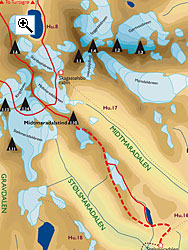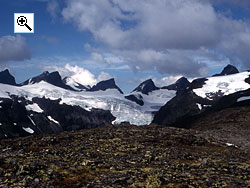Scandinavian Mountains over 2000 metres - James Baxter
Areas › Hurrungane › Midtmaradalstind › Alternative Routes
There are essentially only two options to climb Midtmaradalstind; via the simplest south east ridge and via the much more demanding north west ridge. The south east ridge can be climbed from Hjelle road end by Årdal in an extremely long and arduous day. It is more usual to break this day up by staying in the extremely charming Stølsmaradalen cabin, probably the most idyllic and picturesque of all the DNT cabins. To get this cabin follow route Hu.14 from Hjelle to Vetti Farm and up Brendeteigen for 4½ hours in total, or follow the routes Hu.11 and Hu.13 for 5 hours in total.
The ascent via the north west ridge is for very experienced parties only as it involves glacier travel, climbing to grade III and a very remote location. The climbs starts at Lovskard, but even getting to Lovskard is a challenge in itself. There are 3 options to it get to Lovskard. Firstly from the east via Midtmaradalsbreen, secondly from the west via Stølsmaradalsbreen and the third and most difficult way via the south east ridge of Nordre Midtmaradalstind and Dyrhaugstind.
From the East via Midtmaradalsbreen
The first way from the east over Midtmaradalsbreen is probably the easiest. The route starts from Turtagrø and goes up to 'Bandet' and the Skagastølsbu shelter as per Hu.8. From 'Bandet' the route initially goes south west traversing slightly down across snowfields and rock for ½ km until it reaches the edge of the Midtmaradalsbreen glacier. It then veers south and traverses up across the crevassed glacier for ½ km.
 When on the glacier head towards the bottom of the gully which descends diagonally from the saddle itself. Follow this steep and often icy 40 degree gully up for 150m to the saddle. If the gully is icy some protection might be helpful here.
When on the glacier head towards the bottom of the gully which descends diagonally from the saddle itself. Follow this steep and often icy 40 degree gully up for 150m to the saddle. If the gully is icy some protection might be helpful here.
From the West via Stølsmaradalsbreen
The second way is similar but from the west. This route goes up Ringsdalen and Ringsbreen to Ringsskard as per Hu.18. From Ringsskard head south west under the south face of Østre Ringstind for ½km until you reach its south ridge, where Lovskard is seen from the first time; it is the most northerly, and lowest, of the 3 saddles on the ridge a km to the east.
At the south ridge of Østre Ringstind the glacier drops down steeply for 80m to an almost separate section in a distinct valley. It is easiest to keep closer to the south ridge of Østre Ringstind here, as opposed to the low nunatak further south.
Once at the bottom of this steep crevassed section head north east across the more level glacier for ½ km until the glacier rises up towards the slabs and snowfields under the west side of Lovskard. Keep well to the south of Lovskard where there is a diagonal open gully heading northwards up to the saddle. This gully, which is about 35 degrees for 80m, will be full of snow in the early summer but towards mid summer will be patchy with some easy wet scrambling sections.
Via the South East Ridge of Nordre Midtmaradalstind and Dyrhaugstind
The third approach to Lovskard involves the long descent from Nordre Midtmaradalstind (refer to the Dyrhaugstind page for details on ascending this). This descent initially involves scrambling to grade III down the ridge, until you approach the 4 pinnacles. Before the pinnacles descend a slab on the west side and pass under the pinnacles on the west side, then regain the ridge again. Then follow the ridge down to Lovskard.
 Once at Lovskard follow the ridge south east along a rise on the arête for 250m, which then drops very steeply down to the saddle on the south east side of this rise. The descent to this saddle is best tackled on the loose south west side but the whole rise can also be avoided on the south west side on a series of wide sloping shelves thus avoiding this steep descent.
Once at Lovskard follow the ridge south east along a rise on the arête for 250m, which then drops very steeply down to the saddle on the south east side of this rise. The descent to this saddle is best tackled on the loose south west side but the whole rise can also be avoided on the south west side on a series of wide sloping shelves thus avoiding this steep descent.
Continuing south east there is another rise to be negotiated. The climb out of the saddle onto this rise is initially steep and loose for 10 m but eases of afterwards and is somewhat airy as it follows the arête up and down to the most south easterly saddle at the base of the north west arête of Store Midtmaradalstind.
From this saddle the real ascent begins. It is initially quite simple to follow the arête keeping to the south west of any obstacles until you reach a large overhanging crag, also called 'Halls Hammer' (not to be confused with the Halls Hammer on the Skagastøls ridge). This crag is best avoided on the south west side by initially descending some 30 m down a gully. Then head south along level ledges to reach a larger shelf with some vegetation on it.
Follow this ledge up under an overhanging block until you get to a flatter area. Cross this flatter area and then drop down slightly to a long sloping shelf that leads up to a loose gully. The traverse between the flatter area and the loose gully along the sloping shelf involves climbing to grade III. Once in the loose gully it is easy to follow this up to the main arête again.
Continue to follow the main arête south east over a gently rising section of the arête for a about 100m, until it levels out for 10m before climbing more steeply again. At this 10m level section the is a loose gully that descend to the south west. Do not descend down this gully if going the other way as it ends in an overhang. The route now goes up the arête for a final 100m of grade III scrambling where there are numerous steep steps to surmount. During this final 100m the more difficult scrambles can be eased by veering onto the south west face occasionally.
The time from Turtagrø to Lovskard via Bandet or Ringsskard is 4½ hours, and from Turtagrø to Lovskard via Dyrhaugs ridge is 6½. From Lovskard to the summit is 2 hours. The return journeys by the same route will be slightly shorter. If the return is being made via the ascent route described below allow 4½ hours to Stølsmaradalen cabin.
The route via Bandet over Lovskard then back to Turtagrø via Ringsskard and Ringsdalen is a classic day trip of about 10 hours in the spring on skis. Due to the steepness of the final ascent and descent at Lovskard it is only suitable for experienced parties. The ridge from Lovskard to the summit of Midtmaradalstind however is a very serious undertaking in the spring.
